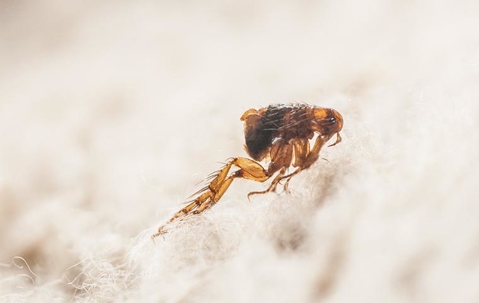Science is very clear about a few things: what goes up must come down, every action has an equal and opposite reaction, and sharing blood with a person that has a blood-borne disease is unwise. As strange as this last scientific truth seems, it is extremely relevant to the two pests we are talking about today: fleas and ticks.
What Are Fleas?
Fleas are small, ⅛” long, six-legged parasitic insects that rely on the blood of people and animals to survive. To obtain a regular meal of blood, this pest jumps onto and cozies up within the fur of an unwilling host. From here, they lay their eggs, try to avoid being scratched or bitten off, and feed to their heart’s content. Inside homes fleas hide inside carpets and tight secluded areas. If no furry animals are around for these pests to feed on, they will take any chance they get to take bites out of humans.
What Are Ticks?
Ticks are ¼ to ⅜” long, eight-legged parasitic arachnids that rely on the blood of people and animals to survive. Unlike fleas, ticks do not live on their hosts, or at least not for very long. To get a blood meal ticks will climb up tall strands of grass or jump from higher hanging leaves or branches to get onto a passing victim. Once aboard, ticks bury their head beneath the skin and draw blood until they are full. Once full, ticks find their way to the ground and relax until they are hungry again.
The Problems Fleas And Ticks Cause
Although different in size, appearance, and classification of animals, the problems fleas and ticks cause are fairly similar. This is mostly because both of these pests aid in the process of blood sharing. When these pests bite an infected individual they run the risk of picking up a blood-borne disease. Anyone bitten after has the risk of contracting whatever bacteria or pathogen fleas or ticks are carrying. Here are some of the most common diseases these pests spread:
- Bubonic plague (fleas)
- Murine typhus (fleas)
- Tungiasis (fleas)
- Tularemia (fleas) (American dog tick)
- Lyme disease (black-legged tick)
- Anaplasmosis (black-legged tick)
- Ehrlichiosis (Lone star tick) (black-legged tick)
- Rocky Mountain spotted fever (American dog tick)
- Babesiosis (black-legged tick)
Preventing Fleas And Ticks
To help you keep these harmful pests off your Daphne property, here are seven great prevention tips to try:
- Install a fence around your yard and garden.
- Mow your grass at least once a week.
- Eliminate clutter and debris from around your property.
- Trim back bushes and tree branches at least five feet from your home’s exterior.
- Use a caulking gun and some steel wool to seal gaps, holes, and cracks in your home’s exterior foundation
- Repair damage to shingles, siding, and your home’s roofline.
- Address issues with window/door screens, weatherstripping, and door sweeps.
When it comes to preventing fleas and ticks, there is one solution that is guaranteed to solve our problem. By getting the experts at Prewett Pest Control involved, you don’t just get protection against pests like fleas and ticks, you get a team of dedicated professionals who will always look out for your best interests.
Contact us today to schedule your home for a service visit or for any questions you have about our flea and tick control.

